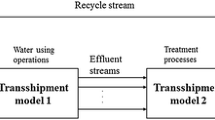Abstract
Procedures of reducing waste water discharges into water bodies to safe levels are described. A technique of evaluating the minimum required water flow rate for the dilution of waste waters containing several harmful substances before their discharge into a water reservoir, as well as evaluating maximum allowable discharges (MADs) of wastewaters, is given. This technique makes it possible to take into account classes of hazard and the summation of effects of substances with the same limiting harmful indices. Expressions for determining the minimum required water flowrate for wastewater dilution were obtained from the condition of admissibility of the effect of several harmful substances on reservoir waters as well as from equations of substance balance in a mixer and the mathematical description of the process of eddy diffusion of substances in the flowing water reservoir. The conditions of admissibility of the effect are presented in the form of logical products of inequalities in which the sums of relative concentrations should not exceed the value of 1. An analytical expression of the dependence of relative substance concentration in the most contaminated jet of the control point of the river on the water flow rate for dilution has been obtained. It is shown that the minimum required water flow rate for wastewater predilution can be calculated only on the basis of a numerical method. An example of numerical calculation of the water flow rate for the predilution of technical facility waste waters containing two substances, polysulfide oil and nitrites, is given for illustrating and testing the technique. In addition to these two harmful substances, the reservoir upstream the point of wastewater discharge contained chrome and fluorine. For nitrites, chrome, and fluorine, the summation of their harmful effects was taken into account. For the example under consideration, it is shown that nitrites can be safely discharged without predilution if the unidirectionality of effects is not taken into account. If the summation of effects of harmful substances is taken into account, it is necessary to predilute waste waters at a dilution multiplicity of 6.4 and a decrease in oil and nitrite concentration by 6.8 and 7.3 times to ensure environmental safety.
Similar content being viewed by others
References
SanPiN 2.1.5.980-00. Drainage of Populated Areas, Sanitary Protection of Water Bodies. Hygienic Requirements for the Protection of Surface Waters, Approved by the Head State Sanitary Doctor of the Russian Federation on June 22, 2000. http://docs.cntd.ru/document/902083726.
GN 2.1.5.1315-03 (July 13, 2017 edition). Hygienic Norms “The Maximum Permissible Concentration (MPC) of Chemicals in Water in the Water Bodies of Domestic-Drinking and Cultural-Domestic Water Use”. http://www.consultant.rucons/cgi/online.cgi?req=doc& base=LAW&n=238192&fld=134&dst=1000000001,0& rnd=0.6350296801107933#0.
On the Approval of Water Quality Standards for Water Bodies of Fishery Importance, Including Standards for Maximum Permissible Concentrations of Harmful Substances in the Waters of Water Bodies of Fishery Importance, Order of the Ministry of Agriculture of the Russian Federation No. 552 of December 13, 2016. http://publication.pravo.gov.ru/Document/View/0001201701160006.
Methodology for the Development of Standards for the Permissible Discharges of Substances and Microorganisms into Water Bodies for Water Users. Approved by the Order of the Ministry of Agriculture of the Russian Federation of December 17, 2007 No. 333, with amendments Nos. 1 and 2 of November 15, 2016. http://files.stroyinf.ru/Data2/1/4293834/4293834833.htm. Accessed December 27, 2017.
RD 34.42.101. Guidelines for the Design of Processing and Purification of Industrial Wastewater of Thermal Power Plants. http://docs.cntd.ru/document/1200043774.
N. I. Serebryanikov, G. V. Presnov, A. M. Khramchikhin, A. S. Sedlov, V. V. Shishchenko, and B. M. Larin, “A strategy for protecting water basins from waste water discharges at the thermal power stations of OAO Mosenergo,” Therm. Eng. 45, 531–536 (1998).
O. G. Morozova, T. L. Kamoza, I. N. Koyupchenko, A. S. Savel’ev, R. Z. Pen, N. S. Veselkova, and M. D. Kudryavtsev, “Operation of a pond-cooler: the case of Berezovskaya GRES-1,” Therm. Eng. 64, 617–622 (2017). doi 10.1134/S0040601517080079
A. Ya. Kopsov, “Specific features relating to implementation of investment projects in the Russian power industry,” Therm. Eng. 57, 641–645 (2010).
A. V. Imeshkenov and V. G. Sudnikovich, “Analysis of wastewater formation in the systems of water disposal of a thermal power plant,” Molodezhnyi Vestn. IrGTU: Elektron. Nauchn. Zh., No. 4 (2011). http://mvestnik.istu.irk.ru/journals/2011/04.
STO 70238424.13.020.30.001-2010 (Standard of NP INVEL). The methodology for calculating the permissible discharges (VAT) of pollutants and heat into surface water bodies with wastewater from thermal power plants and boilers. http://gostrf.com/normadata/1/4293808/4293808250.htm. Accessed September 1, 2015.
A. K. Sokolov, “Considering the summation of the effect of harmful substances during the calculation of the environmentally safe waste water discharge,” Therm. Eng. 64, 652–658 (2017). doi 10.1134/S0040601517090099
A. M. Vladimirov and V. G. Orlov, Protection and Monitoring of Surface Waters: Textbook (RGGMU, St. Petersburg, 2009) [in Russian].
Author information
Authors and Affiliations
Corresponding author
Additional information
Original Russian Text © A.K. Sokolov, 2018, published in Teploenergetika.
Rights and permissions
About this article
Cite this article
Sokolov, A.K. Determination of Minimum Required Water Flow Rate for Diluting Wastewaters before Their Discharge, Taking into Account the Summation of Effects of Harmful Substances. Therm. Eng. 65, 768–774 (2018). https://doi.org/10.1134/S0040601518100099
Received:
Accepted:
Published:
Issue Date:
DOI: https://doi.org/10.1134/S0040601518100099




